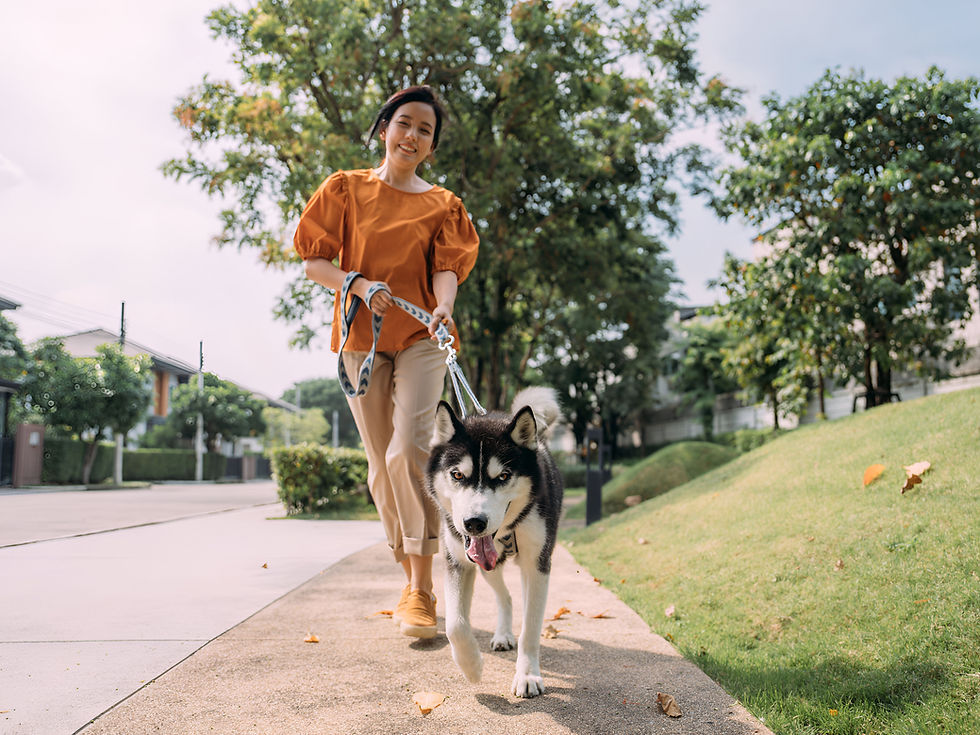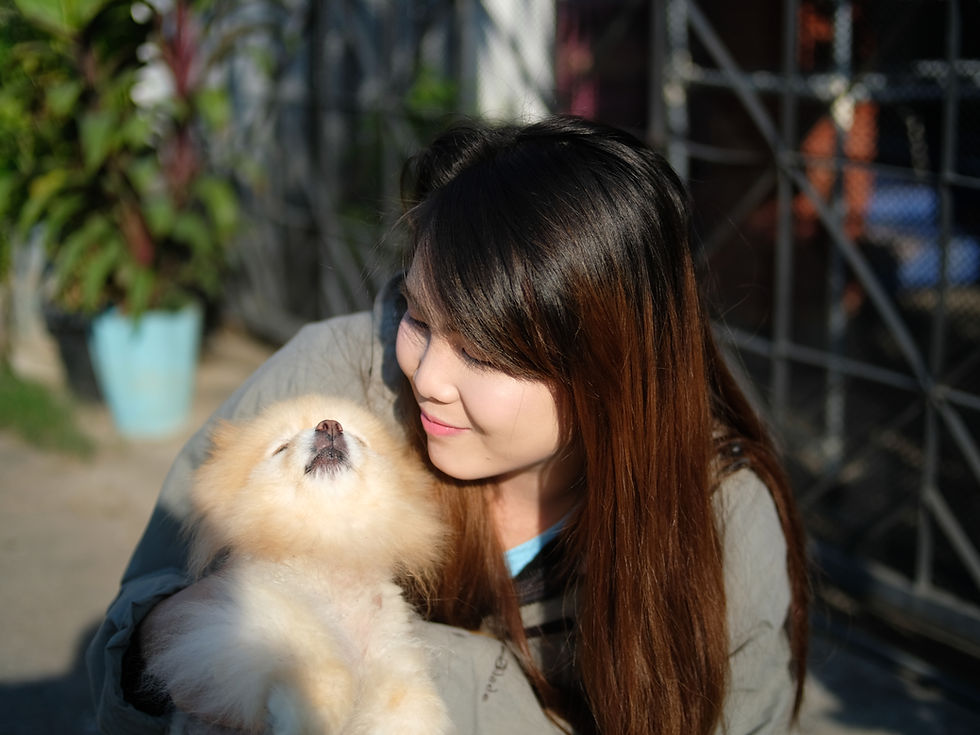從散步到共老:人狗關係的長跑時代
- Jessie Chen
- 2025年8月13日
- 讀畢需時 7 分鐘
已更新:2025年8月14日

對於養狗的飼主來說,帶毛孩散步多半只是每天固定的例常公事;但現在,越來越多飼主開始把狗狗納入更多生活場景:一起跑咖啡廳辦公、陪伴採買、甚至飛到另一個國家度假享樂。
狗狗已不再只是單純的「寵物」,而是旅伴、同事,甚至是家庭成員中最活躍的一員。
▌外出,只是日常的默契
2025 年的數據顯示,59% 的狗主人每週至少一次帶狗外出辦事,比 2023 年增加了 6%。這些外出可能是晨間去便利商店,也可能是到公園買杯咖啡。對狗狗來說,每一次外出都是一次感官探險;對主人來說,這是一種不需要特別安排的默契陪伴。
▌職場中多一位「毛同事」
49% 的狗主人表示,如果公司有寵物友善政策,會非常期待可以帶狗上班。
在越來越多企業開始重視員工幸福感的背景下,狗狗的存在不僅讓辦公室氛圍更溫暖,還成了同事間交流的橋樑。當牠在會議時靜靜趴在你腳邊,那份安心與踏實,是其他辦公室配備給不了的。
▌旅行,不再只規劃人的行程
如今,旅行沒有狗狗,很多主人會覺得少了什麼。
根據旅遊訂票網調查顯示:
* 90% 的主人會和狗一起開車旅行
* 75% 每年至少搭機旅行一次
* 越來越多人一年會帶狗旅行三次以上
從週末的露營、跨縣市自駕,到跨國度假,狗狗正以「全程參與」的姿態融入旅程。牠們或許不懂目的地的意義,但牠們清楚,每一次出門都是一段專屬於你們的故事。

▌與狗共老:相守的真實承諾
除了日常、職場與旅行,近年「與狗一起養老」的概念在台灣與日本悄然興起。
許多中高齡飼主把狗狗視為下半人生的重要伴侶,規劃的生活場景不只是今天的陪伴,而是十年、十五年後依然在彼此身邊。有些退休族選擇搬到寵物友善的養老社區,讓自己在獲得醫療與社交支持的同時,也確保狗狗能擁有適合的生活環境。這種「雙向照護」模式,讓人犬關係更具穩定性,也讓晚年生活多了一份動力與溫度。
▌犬隻共享體驗背後的情感密碼
行為心理學指出,共享經驗能顯著強化人犬之間的情感連結。這不僅是因為互動時間增加,更因為狗狗會透過這些經驗理解你的生活節奏、情緒反應與行為模式,形成深層的安全感與信任感。
從市場觀察來看,這股趨勢也帶動了相關產業的成長:旅行用寵物座椅、行李箱籠、安全帶、便攜餐具、寵物飯店與寵物專屬旅遊保險,都成為高成長品項。
▌亞洲市場的觀察:台日韓的犬隻旅遊與共享日常
* 台灣:在寵物友善餐廳與住宿數量持續增加下,越來越多飼主週末帶狗進行短途旅行。交通部觀光署統計,2024 年國內寵物同行住宿預訂比前年成長約 18%。未來,期待有更多與銀髮養老社區合作的「毛孩長住計畫」實現。
* 日本:受少子化與高齡化影響,許多家庭將狗狗視為主要陪伴對象。2025 年,日本寵物友善觀光市場規模預估將突破 1,500 億日圓,不僅有專屬犬隻列車,還有以狗為主題的整棟溫泉旅館。日本也是最早出現「人犬共老」的住宅設計趨勢,例如樓層規劃包含犬隻散步庭園與寵物醫療中心。
* 南韓:都市養犬人口增加,帶動寵物咖啡館、露營區及犬隻度假村的成長。2024 年,南韓寵物旅遊市場規模達 3,000 億韓元,並有品牌推出「退休族+愛犬慢遊套票」,針對高齡飼主設計輕鬆路線。

▌從日常到產業,犬隻共享體驗的未來
當「與狗一起」成為一種生活方式,不只是寵物服務業受惠,交通、旅遊、餐飲甚至保險業,都能在這股情感驅動的趨勢中找到機會。未來的問題不是「能不能帶狗」,而是「怎麼讓帶狗出門更輕鬆、更安全、更有趣」。
這也是品牌與企業需要思考的核心:我們不只是看到狗狗數量的增長,而是看見了「共享體驗」這種人犬共生關係的深化,正重新定義現代人的生活方式。未來的問題不是「能不能帶狗」,而是「怎麼讓帶狗出門和共老的生活更輕鬆、更安全、更有尊嚴」。
撰文|陳蓁 Jessie Chen( p’adore 寵愛&毛孩居服員等創辦人、《 p’adore Today 寵愛今天》雜誌主筆)
📚資料來源
1.Petfood Industry. (2025).
2.American Pet Products Association (APPA). (2025).
3.Journal of Applied Animal Welfare Science. (2024).
4.交通部觀光署(台灣)寵物旅遊統計(2024)。
5.日本觀光廳「ペット観光市場動向調査」(2024–2025)。
6.韓國觀光公社「반려동물 여행 시장 분석」(2024)。
7.Asahi Shimbun. (2025).
From walking to growing old together: the long-distance relationship between humans and dogs
For dog owners, taking their furry friends for a walk is mostly just a daily routine; but now, more and more owners are starting to incorporate their dogs into more life scenarios: working together in a cafe, accompanying them shopping, and even flying to another country for vacation.
Dogs are no longer just “pets”, but travel companions, colleagues, and even the most active members of the family.
▌Going out is just a daily tacit understanding
Data from 2025 shows that 59% of dog owners take their dogs out for errands at least once a week, a 6% increase from 2023. These outings could be a morning trip to the grocery store or a trip to the park to grab a cup of coffee. For dogs, every outing is a sensory adventure; for owners, it's a tacit, unstructured companionship.
▌Another "Mao colleague" in the workplace
49% of dog owners said they would be excited to bring their dog to work if their company had a pet-friendly policy.
As more and more companies prioritize employee well-being, the presence of dogs not only adds warmth to the office atmosphere but also serves as a bridge for communication between colleagues. When a dog quietly lies at your feet during a meeting, the feeling of peace and security you get is unmatched by any other office amenity.
▌Travel is no longer just about planning your itinerary
Nowadays, many owners feel like something is missing when traveling without their dogs.
According to a survey conducted by the travel booking website:
* 90% of owners travel with their dogs by car
* 75% travel by air at least once a year
* More and more people are traveling with their dogs more than three times a year
From weekend camping trips, cross-county road trips, to international vacations, dogs are becoming fully engaged in every aspect of their journeys. They may not understand the significance of the destination, but they understand that every outing is a story all yours.
Growing Old with a Dog: A True Commitment to Stay Together
In addition to daily life, work, and travel, the concept of "retirement with dogs" has quietly emerged in Taiwan and Japan in recent years.
Many middle-aged and older owners consider their dogs important companions for the rest of their lives, planning not just for today's companionship but also for their continued presence ten or fifteen years from now. Some retirees choose to move into pet-friendly retirement communities, where they can receive medical and social support while also ensuring their dogs have a suitable living environment. This "two-way care" model adds stability to the human-canine relationship and adds motivation and warmth to their later years.
The emotional code behind the shared experience with dogs
Behavioral psychology indicates that shared experiences can significantly strengthen the emotional bond between humans and dogs. This is not only because the interaction time increases, but also because dogs can understand your life rhythm, emotional reactions, and behavioral patterns through these experiences, forming a deep sense of security and trust.
From a market perspective, this trend has also driven the growth of related industries: travel pet seats, luggage cages, seat belts, portable tableware, pet hotels and pet-specific travel insurance have all become high-growth items.
▌Observations on the Asian Market: Dog Tourism and Shared Daily Life in Taiwan, Japan, and South Korea
* Taiwan: With the continued increase in the number of pet-friendly restaurants and accommodations, more and more pet owners are taking their dogs on short weekend trips. According to the Tourism Agency of the Ministry of Transportation and Communications, bookings for pet-friendly accommodations in Taiwan for 2024 increased by approximately 18% compared to the previous year. Looking ahead, we look forward to seeing more "furry-friendly long-term stay programs" in partnership with senior living communities.
* Japan: Driven by declining birthrates and an aging population, many families are turning to dogs as their primary companions. The pet-friendly tourism market in Japan is projected to exceed ¥150 billion by 2025. There are dog-friendly trains and even entire hot spring inns dedicated to dogs. Japan was also an early adopter of the "dog-friendly" residential design trend, with floor plans incorporating dog-friendly gardens and veterinary clinics.
* South Korea: The growing number of urban dog owners is driving the growth of pet cafes, camping areas, and dog resorts. South Korea's pet travel market is projected to reach 300 billion won in 2024, with some brands offering "Retirees + Dog Lovers Slow Travel Packages" designed for elderly pet owners with relaxing itineraries.
From daily life to industry, the future of dog-sharing experiences
When "being with a dog" becomes a lifestyle, it's not just the pet service industry that will benefit. Transportation, tourism, restaurants, and even insurance will all find opportunities in this emotion-driven trend. The question of the future won't be "can we bring our dogs?" but "how can we make taking our dogs out easier, safer, and more fun?"
This is also the core issue that brands and businesses need to consider: We are not just seeing an increase in the number of dogs, but rather the deepening of the symbiotic relationship between humans and dogs through "shared experiences," which is redefining modern lifestyles. The question of the future is not "can we bring dogs?" but "how can we make taking dogs out and aging together easier, safer, and more dignified?"
Written by Jessie Chen (Founder of p’adore & Furry Home Care, Editor-in-Chief of p’adore Today Magazine)
📚 Source
1.Petfood Industry. (2025).
2.American Pet Products Association (APPA). (2025).
3.Journal of Applied Animal Welfare Science. (2024).
4.Tourism Administration, Ministry of Transportation and Communications (Taiwan) Pet Tourism Statistics (2024).
5. Japan Tourism Agency, "Pet Tourism Market Trends Survey" (2024–2025).
6. Korea Tourism Organization “Analysis of the Pet Travel Market” (2024).
7.Asahi Shimbun. (2025).
<<English translation provided by Google>>







留言